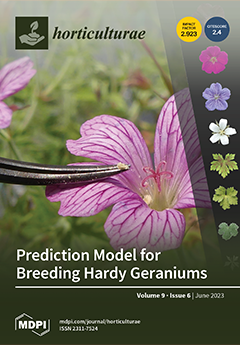The
MYB gene family is significant in plants, playing a role in numerous plant development processes, including metabolism, hormone signal transduction, cell identity, and biotic and abiotic stresses. Due to the recent availability of the
Melastoma candidum genome, this is the first time
[...] Read more.
The
MYB gene family is significant in plants, playing a role in numerous plant development processes, including metabolism, hormone signal transduction, cell identity, and biotic and abiotic stresses. Due to the recent availability of the
Melastoma candidum genome, this is the first time that the
MYB gene family has been identified in this species. This study identified 421
MYB gene members in the
M. candidum genome using the HMMER search and BLASTp method. These
MYBs were further divided into 10 sub-types, including R2R3, R-R, CPC-like, CCA1-like, TBP-like, R1R2R3, I-box, atypical MYB, MYB-CC, and MYB-like. Domain and conservation analyses revealed that each type of MYB was characterized by a different number and combination of SANTs/myb DNA-binding domains. Collinearity analysis revealed several gene duplication events within the
MYB gene family. The Ka to Ks ratio suggested that most of the
MYB genes underwent purifying selection during the evolution process. Phylogenetic analysis among three species confirmed our findings and displayed the evolutionary relationship of
MYB genes in different species. RNA-seq of three developmental stages of flowers and WGCNA analysis identified
McMYB113h,
McMYB21b, and
McGLK1c as playing a pivotal role during flower development in
M. candidum. Finally, we conducted qRT-PCR experiments for 20 flower-development-related
MYBs across 9 tissues to illustrate their expression patterns in
M. candidum. This study establishes a foundation for exploring
MYB gene resources and their potential applications in related industries of
M. candidum.
Full article





